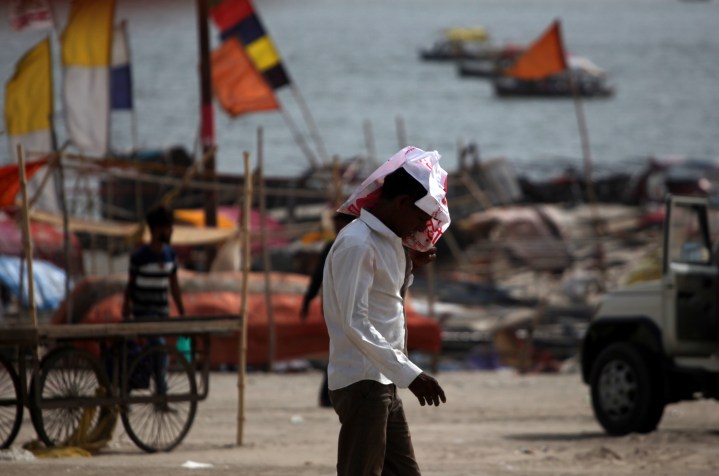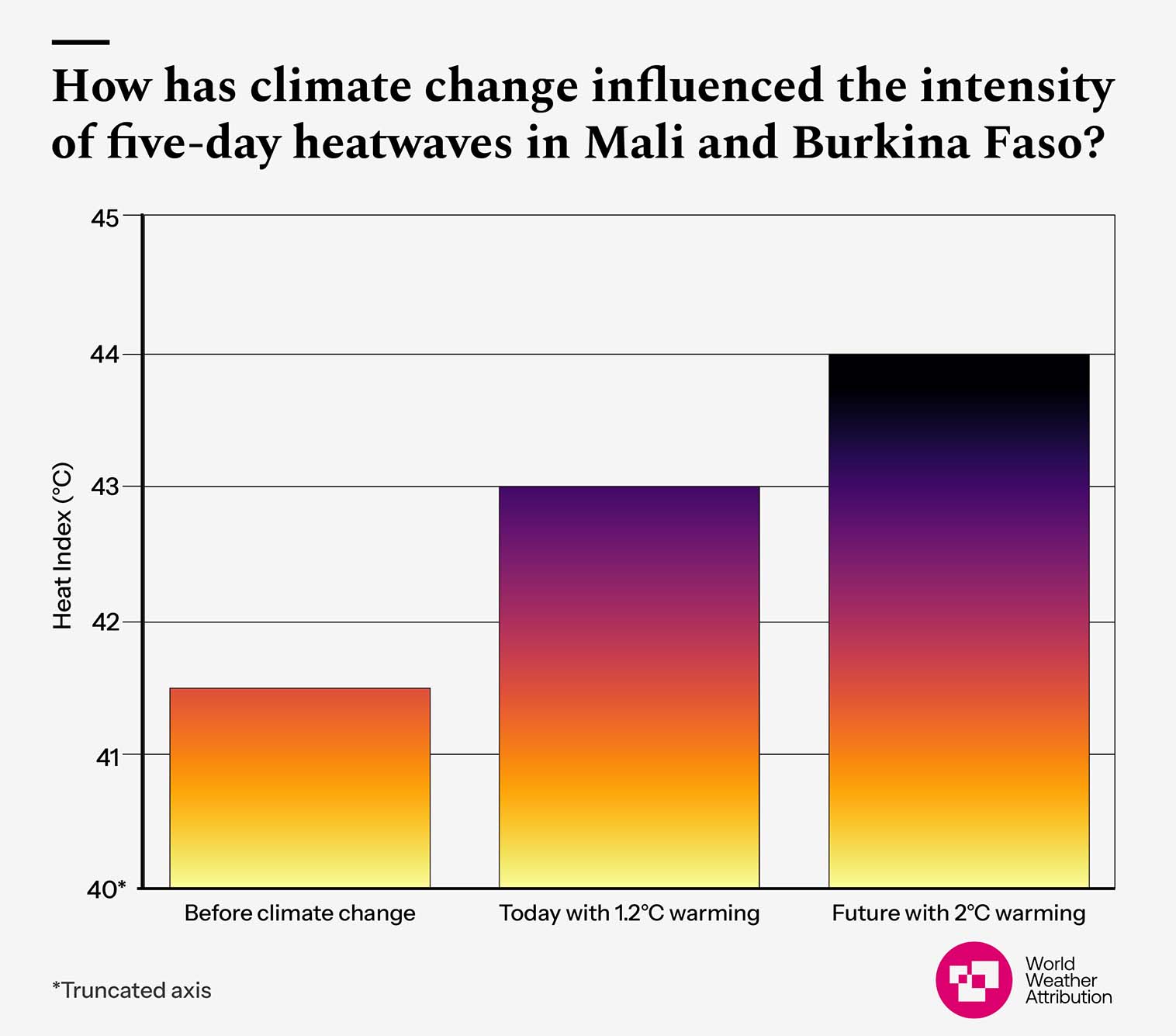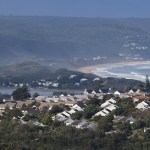HEATWAVE
Deadly climate change-induced furnace strikes in Sahel and West Africa

The end of March and beginning of April 2024 marked a harrowing period for countries in the Sahel and West Africa as an extreme heatwave claimed more than 100 lives and pushed temperatures to staggering heights.
More than 100 people died at the end of March and the beginning of April 2024, as extreme heat swept through a region across the Sahel and West Africa that caused maximum temperatures exceeding 45°C and minimum temperatures of 32°C. Kayes in Mali recorded 48.5°C on 3 April.
The full death toll during heatwaves is difficult to establish and often under-reported until months after the incident, but this time a significant increase in hospital admissions and 102 fatalities were reported from the Gabriel Touré hospital in Bamako, Mali between 1-4 April 2024 – a much higher rate than the 130 recorded over the entire month of April 2023. Hospital reports suggest that heat was likely to have played a role in many of these deaths.
This was revealed during a briefing by World Weather Attribution on 18 April 2024 as scientists from Mali, Burkina Faso, Mozambique, the Netherlands, Sweden, the United States and the United Kingdom presented their new report titled, “Extreme Sahel heatwave that hit highly vulnerable population at the end of Ramadan would not have occurred without climate change”.
The study assessed to what extent human-induced climate change altered the likelihood and intensity of the extreme heat across the Sahel and found that without the continued burning of fossil fuels, the extreme heat in the Sahel that killed hundreds at the end of Ramadan would not have happened.
It looked at countries that had the highest daily and overnight temperatures, and the largest reported death toll: the southern part of Mali and Burkina Faso. Scientists assessed the five-day maximum and minimum temperatures over the March to May season and in April respectively. In addition, they analysed the five-day maximum temperatures from March to May over the larger region encompassing the most affected parts of Senegal, Guinea, Mali, Burkina Faso, Niger, Nigeria and Chad.
Extremely high maximum temperatures were also recorded in Senegal, with several cities reporting temperatures well above 40°C over the first week of April, according to the Senegal Meteorological Agency.
The extreme heat persisted for nearly a week, with brutally hot nights – in Burkina Faso, nights were as hot as 32°C. The extreme heat coincided with Ramadan, a time of fasting, and power cuts which compounded the risk for vulnerable groups and even those not usually considered vulnerable.
To determine to what extent human-caused climate change influenced extreme heat, the scientists combined climate models with observations. Both showed that heatwaves with the magnitude observed in March and April 2024 in the region would have been impossible without the global warming of 1.2°C to date.
The scientists state in the report: “While Burkina Faso and Mali are both countries with populations acclimated to high temperatures, the length and severity of this heatwave made it so that people had a difficult time coping, as evidenced by the reported impacts.
“Therefore, extreme heat is a significant threat in Burkina Faso and Mali, with particularly vulnerable populations including older adults, children, and people with chronic medical conditions.”
The scientists said that even minimum temperatures at night remained relatively high, leaving people without a break from the heat. They said that power cuts also made it more difficult for those with access to air conditioning to use it, thus reducing their coping capacity.
This follows 2023, the planet’s warmest year on record, according to an analysis by scientists from the US’s National Oceanic and Atmospheric Administration (NOAA).
Human-caused climate change
World Weather Attribution research associate and one of the study’s authors, Clair Barnes said, “The heat in the Sahel and West Africa was extraordinary – daytime temperatures pushed well above 40°C, while nighttime temperatures in some regions reached 30°C. Our study joins a mountain of evidence linking dangerous heat with warming caused by fossil fuel emissions.”
Barnes said they found that the five-day heatwave would have been about 1.5°C cooler without climate change, in a pre-industrial climate before the 1.2°C of warming already experienced.
In addition, she said, “It would have been about 1.5°C cooler for daytime temperatures (both across the wider region and southern Mali and Burkina Faso), and the nighttime temperatures would have been about 2°C cooler without climate change — which is a big change because a lot of the impacts can come from those high nighttime temperatures and from people having not [been] able to recover from heat stress overnight.”

(Graphic: World Weather Atribution)
Barnes said they found that a five-day heatwave of this intensity would not have been possible in a pre-industrial climate.
On how the heatwave was affected by El Niño, she said, “We found that the event was made a 10th of a degree warmer by El Niño but that the intensity was not really increased by El Niño. The effect of climate change is much larger.
“We’re confident that this is due to human-caused climate change, and this trend is projected to continue as the world continues to warm,” she said.
Barnes said at 2°C of warming, events like the Sahel heatwave were expected to occur about 10 times more frequently.
“So the prolonged intense heat, like that experienced in Mali and Burkina Faso, a very rare event which currently we would expect once in 200 years, in a 2°C of warming (in a 0.8 degrees warmer climate than now), we would expect similar events to happen maybe once every 20 years. It will become an event that people do need to be prepared to adapt to,” Barnes said.
Read more in Daily Maverick: Deadly heat in West Africa warns of climate change-driven scorchers to come, says report
Another researcher from the study is Friederike Otto, senior lecturer in climate science at Grantham Institute – Climate Change and the Environment, Imperial College London.
Otto said: “Without our continued burning of fossil fuels, extreme heat in the Sahel that killed hundreds at the end of Ramadan would not have happened.”
Otto said extreme heat, driven by climate change, was resulting in death for vulnerable people and attribution studies such as this one clearly showed that if the world continued to burn fossil fuels, the climate would continue to warm and vulnerable people would continue to die.
Vulnerability and exposure
Kiswendsida Guigma, a climate scientist at the Red Cross Crescent Climate Centre in Burkina Faso and another author of the study, said that for some, a heatwave being 1.4 or 1.5°C hotter because of climate change might not sound like a big increase. But he said this additional heat would have been the difference between life and death for many people.
To illustrate the intensity of the heatwave, Guigma said that on average per day four people arrived dead from heat stroke at Yalgado hospital in Ouagadougou, Burkina Faso from mid-March up to now.
Guigma noted that the focus of the study was on Mali and Burkina Faso because this is where impacts were most reported.
When considering the drivers of the vulnerability, Guigma said they had to factor in that the heatwave happened simultaneously with Ramadan this year and as a result, many people were unable to use the common cooling strategies that they would normally have used – like simply drinking water or cold beverages.
Guigma said the event was further exacerbated by power cuts in both Burkina Faso and Mali.
In addition, Guigma said the most vulnerable communities on the outskirts of the cities were the most affected because they lived in areas without enough vegetation coverage, preventing them from having enough coping resources.
According to the Intergovernmental Panel on Climate Change (IPCC) Sixth Assessment Report, exposure and vulnerability to climate change in Africa is multidimensional with socioeconomic, political and environmental factors intersecting.
In terms of action plans, Guigma said that unfortunately in both Burkina Faso and Mali there were no formal early action protocols operational at the time of the heatwave. Red Cross is trying to set up the heatwave early action protocol for the city of Ouagadougou in Burkina Faso, but this was still a work in progress.
“There is a need towards understanding the impacts of extreme heat and also developing early action protocols that will help people be more adapted to these kinds of events,” Guigma said.
The report states that rapid urbanisation and loss of green spaces in cities such as Bamako in Mali and Ouagadougou in Burkina Faso increased the urban heat island effect. Coupled with high vulnerability, this highlighted the need for sustainable urban planning that integrated green spaces and building designs that accounted for high temperatures.
It also states that critical infrastructure such as electricity, water and healthcare systems need to be strengthened to adapt to the increasing frequency and intensity of extreme heat, requiring increased investment to ensure reliable access and service delivery.
Africa’s climate tragedy
If we look at the Sahel heatwave in the context of what the IPCC Sixth Assessment Report reveals, this should not be surprising or unexpected.
Read more in Daily Maverick: Too damn hot — what to expect as global climate crisis heats up in 2024
The IPCC Sixth Assessment Report states that Africa is projected to bear an increasing proportion of global exposed and vulnerable populations at 2°C and 3°C of global warming, and has already experienced widespread impacts from human-induced climate change.
Yet, Africa has among the lowest historical greenhouse gas emissions responsible for human-induced climate change and has the lowest per capita greenhouse gas emissions of all regions.
The report further states, “Temperature increases due to human-caused climate change are detected across Africa and many regions have warmed more rapidly than the global average … A signal of increased annual heatwave frequency has already emerged from the background natural climate variability over the whole continent.” DM


















Comments - Please login in order to comment.